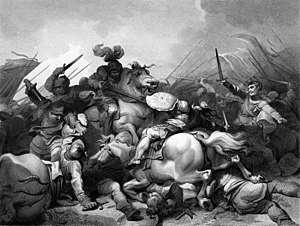
Back معركة بوسوورث Arabic معركة بوسورث ARZ بازورث فیلد دؤیوشو AZB Битка при Босуърт Bulgarian Emgann Bosworth BR Batalla de Bosworth Field Catalan Battle of Bosworth Field CEB Bitva u Bosworthu Czech Brwydr Maes Bosworth CY Slaget ved Bosworth Danish
| Battle of Bosworth | |||||||
|---|---|---|---|---|---|---|---|
| Part of the Wars of the Roses | |||||||
 Battle of Bosworth, as depicted by Philip James de Loutherbourg (1740–1812); the painting dates to 1804 and the engraving dates to c. 1857 | |||||||
| |||||||
| Belligerents | |||||||
|
|
Stanley family | ||||||
| Commanders and leaders | |||||||
|
Baron Stanley Sir William Stanley | |||||||
| Strength | |||||||
| 7,500–12,000 |
5,000–8,000 (including 2,000 French) 4,000–6,000 Stanley men | ||||||
| Casualties and losses | |||||||
| Unknown[1] |
100[2] Stanley losses unknown | ||||||
The Battle of Bosworth or Bosworth Field (/ˈbɒzwərθ/ BOZ-wərth) was the last significant battle of the Wars of the Roses, the civil war between the houses of Lancaster and York that extended across England in the latter half of the 15th century. Fought on 22 August 1485, the battle was won by an alliance of Lancastrians and disaffected Yorkists. Their leader Henry Tudor, Earl of Richmond, became the first English monarch of the Tudor dynasty by his victory and subsequent marriage to a Yorkist princess. His opponent Richard III, the last king of the House of York, was killed during the battle, the last English monarch to fall in battle. Historians consider Bosworth Field to mark the end of the Plantagenet dynasty, making it one of the defining moments of English history.
Richard's reign began in 1483 when he ascended the throne after his twelve-year-old nephew, Edward V, was declared illegitimate. The boy and his younger brother Richard soon disappeared, and their fate remains a mystery. Across the English Channel Henry Tudor, a descendant of the greatly diminished House of Lancaster, seized on Richard's difficulties and laid claim to the throne. Henry's first attempt to invade England in 1483 foundered in a storm, but his second arrived unopposed on 7 August 1485 on the southwest coast of Wales. Marching inland, Henry gathered support as he made for London. Richard hurriedly mustered his troops and intercepted Henry's army near Ambion Hill, south of the town of Market Bosworth in Leicestershire. Lord Stanley and Sir William Stanley also brought a force to the battlefield, but held back while they decided which side it would be most advantageous to support, initially lending only four knights to Henry's cause; these were: Sir Robert Tunstall, Sir John Savage (nephew of Lord Stanley), Sir Hugh Persall and Sir Humphrey Stanley.[3] Sir John Savage was placed in command of the left flank of Henry's army.
Richard divided his army, which outnumbered Henry's, into three groups (or "battles"). One was assigned to the Duke of Norfolk and another to the Earl of Northumberland. Henry kept most of his force together and placed it under the command of the experienced Earl of Oxford. Richard's vanguard, commanded by Norfolk, attacked but struggled against Oxford's men, and some of Norfolk's troops fled the field. Northumberland took no action when signalled to assist his king, so Richard gambled everything on a charge across the battlefield to kill Henry and end the fight. Seeing the king's knights separated from his army, the Stanleys intervened; Sir William led his men to Henry's aid, surrounding and killing Richard. After the battle, Henry was crowned king.
Henry hired chroniclers to portray his reign favourably; the Battle of Bosworth Field was popularised to represent his Tudor dynasty as the start of a new age, marking the end of the Middle Ages for England. From the 15th to the 18th centuries the battle was glamourised as a victory of good over evil, and features as the climax of William Shakespeare's play Richard III. The exact site of the battle is disputed because of the lack of conclusive data, and memorials have been erected at different locations. The Bosworth Battlefield Heritage Centre was built in 1974, on a site that has since been challenged by several scholars and historians. In October 2009, a team of researchers who had performed geological surveys and archaeological digs in the area since 2003 suggested a location two miles (3.2 km) southwest of Ambion Hill.
- ^ Chrimes 1999, p. 49.
- ^ Vergil, Polydore. "Anglica Historia (1555 version)". The Philological Museum of the University of Birmingham. Retrieved 29 August 2016.
- ^ The Ballad of Bosworth Fielde, Text from Bishop Percy's Folio Manuscript. Ballads and Romances, ed. J.W. Hales and F.J. Furnivall, 3 vols. (London, 1868), III, pp. 233–259. Reproduced by kind permission of Department of Special Collections, University of Pennsylvania Library